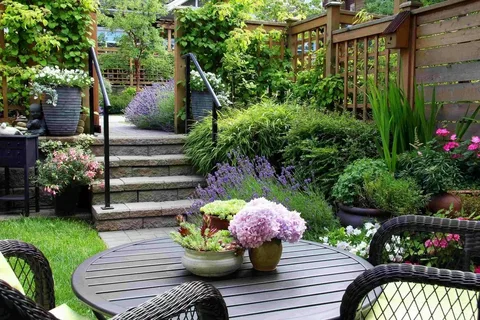Creating a garden that is both beautiful and functional can transform your outdoor space into a personal oasis. Whether you have a sprawling backyard or a compact urban plot, thoughtful design can make your garden a space where you can relax, entertain, and grow your own plants. Here are some garden design ideas to inspire your next outdoor project.
1. Embrace the Power of Zoning
Dividing your garden into different zones can enhance both its functionality and visual appeal. Consider creating distinct areas for dining, lounging, and planting. For example, a patio with comfortable seating can serve as an outdoor living room, while a dedicated vegetable patch or raised beds can be your go-to spot for growing herbs and produce. Use pathways, hedges, or pergolas to define these zones.
2. Incorporate Vertical Gardening
If space is limited, or you want to add an extra dimension to your garden, consider vertical gardening. This technique involves growing plants upward, using structures like trellises, wall-mounted planters, or hanging baskets. Vertical gardens are perfect for small spaces and can be used to grow anything from flowers and herbs to climbing plants like ivy or clematis.
3. Create a Focal Point
A focal point can anchor your garden design and draw the eye to a specific area. This could be a beautiful tree, a water feature like a fountain or pond, or even a piece of garden art or a sculpture. A well-placed focal point can add interest to your garden and make it feel more cohesive.
4. Use Native Plants
Incorporating native plants into your garden not only supports local wildlife but also ensures that your garden is well-suited to the local climate. Native plants typically require less water and maintenance, making them a practical choice for a functional garden. Plus, they can help attract pollinators like bees and butterflies, adding to the beauty and ecological value of your garden.
5. Integrate Edible Landscaping
Why not combine beauty and utility by integrating edible plants into your garden design? Edible landscaping involves using fruit trees, berry bushes, and herb beds as part of your overall garden layout. Not only do these plants provide fresh produce, but they can also be visually appealing, especially when mixed with ornamental flowers and shrubs.
6. Incorporate Water Features
Water features like ponds, fountains, or even a small birdbath can bring a sense of tranquility to your garden. The sound of running water can be soothing, and water features can also attract wildlife, adding life and movement to your garden. Consider the scale of your garden when choosing a water feature to ensure it complements the space.
7. Opt for Low-Maintenance Plants
If you prefer to spend more time enjoying your garden than maintaining it, opt for low-maintenance plants. Drought-tolerant perennials, ornamental grasses, and hardy shrubs require less water and care, making them ideal for a functional garden. Ground covers like creeping thyme or sedum can also help reduce the need for weeding and watering.
8. Design with All Seasons in Mind
To keep your garden looking beautiful year-round, choose plants that offer interest in different seasons. For example, spring bulbs like daffodils and tulips provide early color, while summer perennials like lavender and coneflowers keep the garden vibrant in the warmer months. In autumn, ornamental grasses and trees with colorful foliage can add texture and warmth, while evergreens ensure that your garden remains green and structured throughout winter.
9. Incorporate Outdoor Lighting
Outdoor lighting can extend the use of your garden into the evening and highlight key features after dark. Consider installing string lights along a pergola, solar-powered stake lights along pathways, or spotlights to showcase trees or architectural elements. Proper lighting not only enhances the beauty of your garden but also improves safety and accessibility.
10. Add Comfortable Seating
A garden should be a place where you can relax and enjoy nature, so comfortable seating is essential. Whether it’s a cozy bench under a tree, a set of lounge chairs on the patio, or a hammock between two trees, make sure you have a spot to sit back and take in the beauty of your surroundings. Choose weather-resistant materials and include cushions for further comfort.
11. Incorporate Sustainable Practices
Sustainability is an important consideration in modern garden design. Incorporate practices like composting, rainwater harvesting, and using organic fertilizers to reduce your garden’s environmental impact. Consider using recycled materials for garden structures, and choose plants that are adapted to your local climate to reduce water usage and the need for chemical treatments.
Conclusion
Designing a garden that is both beautiful and functional requires thoughtful planning and creativity. By incorporating elements like zoning, native plants, water features, and sustainable practices, you can create an outdoor space that is not only visually appealing but also serves your needs. Whether you’re starting from scratch or looking to update an existing garden, these ideas will help you create a space that you can enjoy for years to come.

